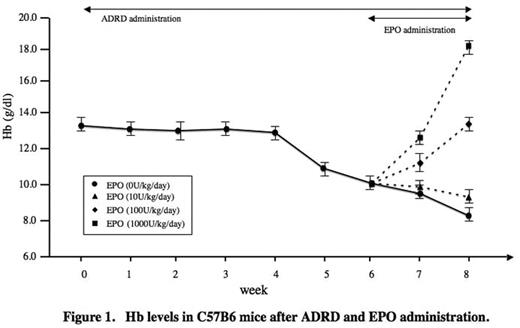Abstract
Recombinant human erythropoietin (rh-EPO) administration results in a dramatic improvement of anemia due to chronic renal failure (ACRF). We reported that excessive apoptosis in erythroid progenitors was observed in ACRF patients before rh-EPO administration, and that we have established the model mouse of ACRF by administration of adenine-rich diets (ADRD) in ASH meetings 2001 and 2006. In this study, we evaluated the frequency of apoptosis in bone marrow erythroid cells of the model mouse before and after erythropoietin (EPO) administration, to confirm the hypothesis that excessive apoptosis in erythroid progenitors induced anemia via insufficient production of EPO. ADRD was administrated to C57B6 male mice for 8 weeks. Every day subcutaneous administration of EPO started at 6 weeks and continued for 2 weeks. Serum BUN and Crt levels began to elevate from 2 weeks after ADRD administration (Table1). Hb levels began to decrease from 5 weeks after ADRD administration and increased after EPO administration in a dose dependent manner (Table1, Figure1). The frequencies of apoptosis in erythroid progenitors and mature erythroblasts were evaluated by three color flow cytometric analysis using anti-CD34-antibody, anti-EPO-receptor (EPO-R)-antibody and AnnexinV. Erythroid progenitors were identified as CD34(+) and EPO-R(+) cells, and mature erythroblasts identified as CD34(−) and EPO-R(+) cells. Much higher frequency of apoptosis was observed in erythroid progenitors at 6 weeks after ADRD administration (76.4±5.3%, n=4), while, the frequency of apoptosis decreased dramatically after EPO administration in a dose dependent manner (0U/kg/day: 70.1±6.9% at 7 weeks, 73.8±8.7% at 8 weeks, 10U/kg/day: 48.1±5.4%* at 7 weeks, 46.9±4.2%* at 8 weeks, 100U/kg/day: 36.9±2.5%* at 7 weeks, 21.2±6.8%* at 8 weeks, 1000U/kg/day: 18.4±2.9%* at 7 weeks, 15.1±3.5%* at 8 weeks, each n=4, *p<0.01) (Figure2). The frequency of apoptosis was not increased in mature erythroblasts at each week after ADRD administration. Our findings suggested that excessive apoptosis occurred mainly in CD34(+) erythroid progenitors by insufficient production of EPO, and that EPO had the anti-apoptotic effect to erythroid progenitors. Insufficient production of EPO might be one of the important causes of ACRF.
BUN, Crt and Hb levels in C57B6 mice after ADRD administration.
| . | 0 week . | 2 weeks . | 4 weeks . | 5 weeks . | 6 weeks . | 7 weeks . | 8 weeks . |
|---|---|---|---|---|---|---|---|
| BUN (mg/dl) | 40.1±4.60 | 73.2±14.4 | 150.7±11.6 | 148.8±4.60 | 164.0±8.40 | 161.8±16.4 | 193.0±9.10 |
| Crt (mg/dl) | 0.06±0.04 | 0.30±0.03 | 0.51±0.07 | 0.52±0.09 | 0.68±0.09 | 0.65±0.04 | 0.80±0.17 |
| Hb (g/dl) | 13.6±0.4 | 13.3±0.3 | 13.2±0.2 | 11.1±0.1 | 10.2±0.5 | 9.6±0.1 | 8.3±0.5 |
| . | 0 week . | 2 weeks . | 4 weeks . | 5 weeks . | 6 weeks . | 7 weeks . | 8 weeks . |
|---|---|---|---|---|---|---|---|
| BUN (mg/dl) | 40.1±4.60 | 73.2±14.4 | 150.7±11.6 | 148.8±4.60 | 164.0±8.40 | 161.8±16.4 | 193.0±9.10 |
| Crt (mg/dl) | 0.06±0.04 | 0.30±0.03 | 0.51±0.07 | 0.52±0.09 | 0.68±0.09 | 0.65±0.04 | 0.80±0.17 |
| Hb (g/dl) | 13.6±0.4 | 13.3±0.3 | 13.2±0.2 | 11.1±0.1 | 10.2±0.5 | 9.6±0.1 | 8.3±0.5 |
Hb levels in C57B6 mice after ADRD and EPO administration.
Hb levels in C57B6 mice after ADRD and EPO administration.
The frequency of apoptotic cells positive for CD34 and EPO-R in C57B6 mice after ADRD and EPO administration.
The frequency of apoptotic cells positive for CD34 and EPO-R in C57B6 mice after ADRD and EPO administration.
Author notes
Disclosure: No relevant conflicts of interest to declare.



This feature is available to Subscribers Only
Sign In or Create an Account Close Modal